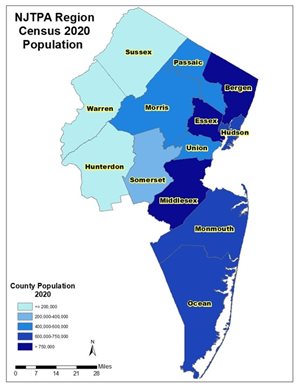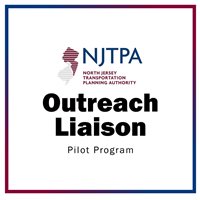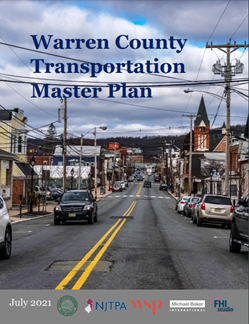October 2021
Posted: 10/22/2021 10:54:11 AM
 Logistics problems are plaguing the shipment and delivery of goods nationwide. At the October 18 NJTPA Freight Initiatives Committee, members heard that these problems are as not as severe in our region as elsewhere. They also were briefed on air cargo industry efforts to help ease the crisis, as well UPS’s exploration of future maritime shipping options.
Logistics problems are plaguing the shipment and delivery of goods nationwide. At the October 18 NJTPA Freight Initiatives Committee, members heard that these problems are as not as severe in our region as elsewhere. They also were briefed on air cargo industry efforts to help ease the crisis, as well UPS’s exploration of future maritime shipping options.
Anne Strauss Wieder, NJTPA Director of Freight Planning, gave an overview of recent regional freight trends, noting that container activity at the port rebounded strongly beginning last fall and now surpasses pre-pandemic levels. Currently, she said, only three vessels were anchored off the port awaiting berths. This contrasts, she said, with the backlogs at other ports including 25 vessels at Savannah and 80 or more at southern California ports.
Still, she said, freight logistics in the region is hampered by the ongoing worker shortage – particularly truck drivers. She also noted the continued rapid expansion of warehouse facilities in the region.
Committee Chair and Middlesex County Commissioner Charles Kenny introduced speakers Brandon Fried, Executive Director of the Air Forwarders Association, who spoke on the state of the air cargo industry; and Christopher Lutick, Director, State Government Affairs at UPS, who spoke about his company’s initiatives in the NJTPA Region.
Fried said the surge of online buying and demand for goods, has exacerbated problems in the freight industry, including worker shortages, inadequate port infrastructure, shortages of truck chassis at ports and other factors. He said the air cargo industry has played a significant role in addressing the current “overflow of goods in the supply chain.”
While most air cargo has traditionally flown in the bellies of passenger planes, he said the increasing air cargo demands have prompted all major carriers to convert a share of passenger planes to full cargo carriers, loading packages into seats instead of people. United Airlines has run 15,000 of these “passenger freighters,” he said. But he noted congestion at airports and lack of capacity to handle truck traffic due to older infrastructure are limiting air cargo expansion.
Also of great concern, he said, are cybersecurity threats and the need for regulation and enforcement to prevent dangerous goods—particularly carelessly packaged lithium batteries – from being shipped as air cargo, creating potentially “catastrophic” events.
Lutick described an effort by UPS to explore moving truck trailers by barge or high-speed ferry between New Jersey and New York to avoid highway congestion and reduce environmental impacts. Among the locations in New Jersey are Kearny and the new UPS facility to be built in Bayonne at the former Military Ocean Terminal.
He said the concept was tested this summer. One issue was that loading 14 to 20 trailers on a barge required special ramps because of the skirts commonly installed on trailers to reduce wind resistance. This type of trailer transport, he said, operates successfully on Lake Champlain with a dedicated vessel. He said the concept will undergo further development over the next two years.
If the service could accomplish three to four trips per day between New York and New Jersey, he predicted, other companies beyond UPS would be attracted, enabling them “to take advantage of the short hop across the water” to move their goods.
A recording of the meeting and copies of the presentations are available for download.
Posted: 10/21/2021 2:24:58 PM
 The population of the NJTPA’s 13-county region grew 6.8 percent — nearly a percentage point higher than statewide growth — from 2010 to 2020, according to the latest U.S. Census data. This growth far exceeded pre-2020 Census estimates, which projected a 1.8 percent population increase.
The population of the NJTPA’s 13-county region grew 6.8 percent — nearly a percentage point higher than statewide growth — from 2010 to 2020, according to the latest U.S. Census data. This growth far exceeded pre-2020 Census estimates, which projected a 1.8 percent population increase.
The region’s population is just above 7 million, 445,322 people higher than it was in the 2010 Census. New Jersey’s total population is now just shy of 9.3 million. Robert Diogo, Manager of Modeling at the NJTPA, presented that data to the Regional Technical Advisory Committee on October 12.
In addition to population counts, the Census provides data on the state’s racial and ethnic mix, a breakdown of age groups and information about housing vacancy rates. Additional data, including more detailed age breakdowns, will be released in 2022.
The data is important because it is factored into funding formulas, helps inform planning studies and needs assessments and equity analyses. It also is the basis for modeling and forecasting.
Hudson, Essex, Ocean, Middlesex and Bergen counties saw the largest growth. Warren and Hunterdon had minimal growth (less than 1,000 people), while Sussex County saw a population decrease of about 5,000. It’s too early to say how the pandemic affected the count and responses to the Census Bureau’s American Community Survey, or how it will affect future growth since remote work resulted in some people moving out of urban areas and while seeking housing in more suburban and rural communities.
ewark remains the state’s most populous municipality, with 311,549 residents, an increase of 12.4 percent. Jersey City is a close second with 292,449 residents, an increase of 18.1 percent. Lakewood, the most populous municipality in Ocean County, had the largest percentage increase in the region, growing from 92,843 in 2010 to 135,158 in 2020, an increase of 45.6 percent.
Posted: 10/6/2021 11:29:38 AM
 The NJTPA has launched a pilot Outreach Liaison Program, which aims to recruit community members to help advance public involvement in the agency’s projects and programs.
The NJTPA has launched a pilot Outreach Liaison Program, which aims to recruit community members to help advance public involvement in the agency’s projects and programs.
Ideal candidates are members of grassroots networks who are passionate about community involvement in transportation projects and funding decisions. The liaisons would help facilitate communication between the agency and communities, with an emphasis on reaching groups that have been traditionally under-represented in transportation planning.
Outreach liaisons would help tailor the NJTPA’s public outreach strategies to the specific needs of a project or study area’s ethnic or cultural groups. Liaisons may offer knowledge about cultural nuances, interface with community members on behalf of the agency, facilitate community meetings or events, and provide translation services, if needed.
This is a two-year pilot program. The first year will focus on recruiting five outreach liaisons, who would receive training on public engagement techniques and background on NJTPA projects and programs. In the spring, liaisons would work alongside NJTPA staff and consultants on public engagement initiatives, such as attending public meetings. In the second year, liaisons will help plan and facilitate their own outreach events, coordinating with local organizations, and reporting residents’ feedback and concerns to the NJTPA.
Liaisons will be paid a stipend for their time. Only applicants living in the NJTPA’s 13-county region (Bergen, Essex, Hudson, Hunterdon, Middlesex, Morris, Monmouth, Ocean, Passaic, Somerset, Sussex, Warren and Union counties) will be considered for the program.
The deadline to apply for the program is November 30. Click here to submit an application.
Posted: 10/5/2021 3:51:57 PM
 Warren County recently updated its Transportation Plan, which presents a vision for the future of the county’s transportation network through the year 2045.
Warren County recently updated its Transportation Plan, which presents a vision for the future of the county’s transportation network through the year 2045.
The project team reviewed existing conditions of roads, bridges, pedestrian infrastructure and transit. Computer models were used to explore different scenarios, including the impacts of industrial development and population changes in different parts of the County. For example, one model considered targeting residential development into existing regional centers, which have access to transportation options. This could help maximize active transportation modes (like walking and biking) while mitigating traffic congestion. The models were also used to explore road improvements that might be needed if certain parts of the County were developed for light industrial uses, such as warehouses or distribution centers.
The County conducted extensive public and stakeholder outreach to gather input for the Transportation Plan. This included a study website, virtual public meetings and focus groups. Presentations were pre-recorded in English and Spanish and shared on the study website so that community members could view them at any time and provide input.
The plan identifies road and bridge improvements, including addressing weight restrictions that can impede the movement of goods by truck. It also suggests bicycle and pedestrian safety improvements, and policy recommendations, such as adopting a countywide Complete Streets policy. Complete streets are roads designed users of all modes and ability levels. The plan notes that while Warren County is rural, communities with developed centers, such as Phillipsburg, Hackettstown, and Washington Borough could benefit from the policy, which could include installing traffic calming elements to improve pedestrian safety.
The County can use the data and recommendations in the plan as it considers future land use, transportation and infrastructure decisions. The plan also identifies projects that require further study before implementation, including developing a master plan for walking and biking, which could include the creation of an on- and off-road bicycle network.
Click here to view the Warren County Transportation Plan.
This study was completed through the NJTPA’s Subregional Studies Program, which provides two-year grants on a competitive annual basis to the 13 counties and two cities — known as subregions — represented on the NJTPA Board.
The program aims to help subregions develop recommendations for transportation improvements that inform and implement the NJTPA’s Long Range Transportation Plan.